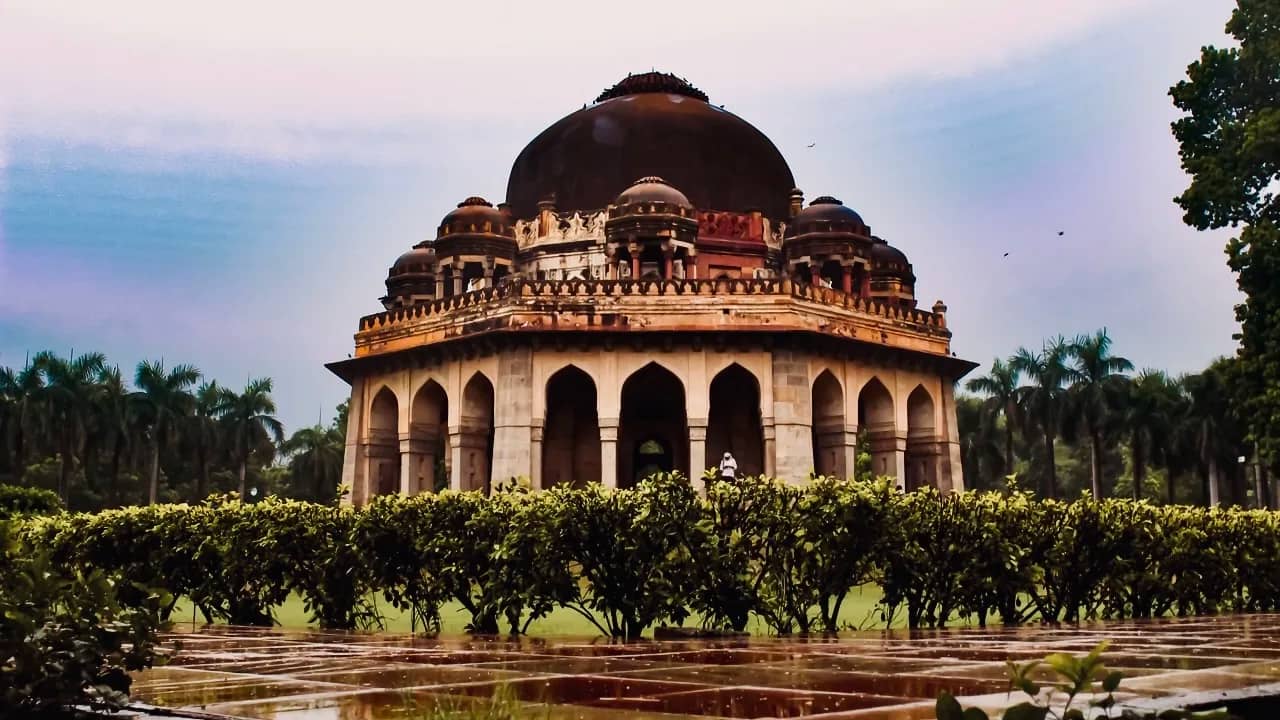Lodhi garden
Lodhi Garden, located in the heart of India’s bustling capital, Delhi, is a beautiful retreat that seamlessly blends history, architecture, and nature. Spanning over 90 acres, this verdant oasis is not just a park but a living testament to the city’s rich heritage. Established in the 15th century, Lodhi Garden showcases the architectural splendours of the Lodhi and Sayyid dynasties through well-preserved tombs and structures. Majestic trees, vibrant flower beds, and serene water features create a picturesque landscape, inviting locals and tourists to indulge in its tranquillity. As a green lung amidst urban chaos, Lodhi Garden serves as a haven for morning joggers, art enthusiasts, and those seeking solace in the lap of nature, making it an integral part of Delhi’s cultural and recreational tapestry.
You may also consider visiting the tomb of Safdarjung.
Exploring the historical tapestry of Lodhi Garden
Lodhi Garden is situated in the heart of Delhi and is a historical site that dates back to the 15th century. It is a scenic park and an open-air museum that preserves the architectural legacy of the Lodhi and Sayyid dynasties.
The garden was commissioned by Sikander Lodi in 1494 and was initially intended to serve as a burial ground for the royal family. Walking through Lodhi Garden today, you can feel the site’s historical significance, with monuments and tombs scattered throughout the landscape.
The most notable structures in the garden include the tomb of Sikander Lodi, the last ruler of the Lodhi dynasty, and Muhammad Shah Sayyid’s Tomb, an excellent example of Indo-Islamic architecture. Each edifice showcases intricate carvings, calligraphy, and ornate domes that reflect the artistic prowess of the bygone eras.
The garden also houses the Shisha Gumbad and Bara Gumbad, adding to its grandeur. The Shisha Gumbad is adorned with glazed tiles, and the imposing Bara Gumbad’s impressive dome contributes to the park’s unique charm.
Lodhi Garden is a must-visit for history enthusiasts, as it offers a glimpse into the lives and legacies of the rulers who once graced Delhi’s throne. The well-preserved tombs and structures are silent witnesses to the cultural and architectural transitions that have shaped the city over centuries, making Lodhi Garden a tranquil retreat and a living testament to Delhi’s storied past. Visitors can immerse themselves in the grandeur and cultural richness that defines Lodhi Garden within this historical tapestry.
Architectural Marvels of Lodhi Garden

Lodhi Garden, situated in the heart of Delhi, tells the story of architectural brilliance, with each structure showcasing the grandeur of the Lodhi and Sayyid dynasties. The park is a treasure trove of historical monuments that take visitors on a remarkable journey through time.
At the centre of this architectural wonder is Sikander Lodi’s Tomb, a masterpiece that reflects the Indo-Islamic style of the 15th century. The tomb, surrounded by lush greenery, features intricate calligraphy, geometric patterns, and ornate domes, highlighting the aesthetic finesse of the Lodhi era.
Another gem within Lodhi Garden is the Muhammad Shah Sayyid’s Tomb. Its octagonal structure, adorned with stunning jaali work, combines Persian and Indian architectural elements. When the sunlight filters through the perforated screens, it creates a mesmerising interplay of light and shadow, amplifying the ethereal beauty of the tomb.
The Shisha Gumbad, with its glazed tiles that once reflected the sun like a mirror (“shisha” in Persian), stands as a testament to the innovative architectural techniques of the Sayyid period. Nestled amid greenery, this tomb is a visual delight, adorned with blue and turquoise tiles that have stood the test of time.
Adjacent to the Shisha Gumbad is the imposing Bara Gumbad, notable for its massive dome and three arched openings. Despite its simple design, its grandeur is a striking example of medieval architecture.
Lodhi Garden offers a serene environment for history enthusiasts and casual visitors, with its architectural marvels and lush landscapes. These structures’ intricate detailing, symmetrical layouts, and overall aesthetic harmony contribute to Lodhi Garden’s timeless allure, making history preserved and celebrated in every arch, dome, and carved stone.
In addition to its historical significance, Lodhi Garden is also a lush sanctuary, nurturing a diverse tapestry of flora and fauna within the bustling heart of Delhi. Spanning 90 acres, the park is a testament to the city’s commitment to preserving nature amidst urbanisation.
Flora:
The green canvas of Lodhi Garden is painted with a rich palette of flora, providing a soothing retreat for visitors. Ancient trees, some dating back centuries, stand tall, offering shade and tranquillity. The park boasts a variety of indigenous and exotic species, creating a diverse ecosystem. From towering Banyans to the delicate blooms of seasonal flowers, the landscape changes hues with the seasons, ensuring a visual feast for nature enthusiasts.
Lodhi Garden is a park that offers a diverse range of plant life. The presence of butterfly-attracting plants is a highlight of the park, contributing to its biodiversity. The fragrance of blossoms creates a sensory experience that blends harmoniously with the historic ambience.
Lodhi Garden is a beautiful park and a thriving habitat for many species of birds and small animals. Birdwatchers can spot various avian species, including playful parakeets and graceful herons. The serene water features, such as the reflective pond, attract migratory birds, making it a paradise for bird watchers.
The park’s biodiversity extends to smaller inhabitants, such as squirrels, butterflies, and occasionally colourful dragonflies, which adds to the vibrancy of the ecosystem. The coexistence of flora and fauna transforms Lodhi Garden into a living, breathing entity, creating an immersive experience for visitors.
The park management tries to preserve and enhance biodiversity by ensuring the well-being of trees and plants. They have introduced meticulous landscaping and conservation initiatives. Additionally, educational programs on biodiversity are conducted, engaging visitors and local communities in the importance of preserving and respecting the natural elements within Lodhi Garden.
Lodhi Garden’s well-maintained lawns provide a picturesque setting for various recreational activities. Families can enjoy picnics on the grassy expanses, yoga enthusiasts can find tranquillity under the shade of ancient trees, and fitness enthusiasts can engage in outdoor activities. The green spaces serve as a canvas for many activities, blending leisure with the therapeutic benefits of nature.
The best time to visit Lodhi Garden
The best time to visit Lodhi Garden in New Delhi is winter, specifically from November to February. The weather is relatively mild and pleasant during this period, making it an ideal time for outdoor activities and strolls through the park. The temperature ranges from around 7 to 20 degrees Celsius (45 to 68 degrees Fahrenheit), creating a comfortable and enjoyable atmosphere for visitors.
Visiting Lodhi Garden in winter allows you to experience clear skies and cool breezes, which enhances the overall experience of exploring the park’s historical and lush green surroundings. The garden boasts various flora, including ancient trees and vibrant flowers, which are at their best during winter.
Moreover, the winter months coincide with the peak season for tourism in Delhi, and the park is less crowded than it is during the scorching summer months. This allows visitors to fully appreciate the serene ambience and architectural marvels within Lodhi Garden, such as the tombs and monuments dating back to the 15th century.
In conclusion, winter is the best time to visit Lodhi Garden for a delightful and comfortable experience. Enjoy the pleasant weather, explore the park’s natural beauty, and appreciate the historical architecture without worrying about the crowds.
How to Reach Lodhi Garden in Delhi

Lodhi Garden is a peaceful retreat amid bustling Delhi, and it is easily accessible by various modes of transport. Whether you are a local or a tourist exploring the city, getting to Lodhi Garden is a simple and enjoyable journey.
By Metro:
The Delhi Metro is one of the most convenient ways to reach Lodhi Garden. The nearest metro station is Jor Bagh Metro Station on the Yellow Line. You can take a short auto-rickshaw ride from the station or enjoy a pleasant stroll to the garden. The metro route offers a hassle-free and eco-friendly option for visitors.
By Bus:
Lodhi Garden is well-connected by an extensive network of buses in Delhi. Several bus routes pass through the garden or have stops nearby. The park’s proximity to Lodhi Road makes it accessible through bus services. Could you check local bus schedules and routes to plan your journey?
By Auto-rickshaw or Taxi:
Auto-rickshaws and taxis provide convenient and flexible transportation to Lodhi Garden. Could you give the park’s name and address? Most drivers will know the location. It is advisable to use ride-sharing apps for taxis, ensuring a transparent and comfortable ride.
By Car:
If you plan to visit Lodhi Garden by car, you’ll be pleased to know that the park has plenty of parking facilities near its entrance. This makes it easy for visitors to park and explore the park at their own pace. GPS navigation or map apps can guide you to the park and enjoy a smooth drive to this green haven.
On Foot or Bicycle:
Lodhi Garden is a great place for pedestrians with pleasant walking paths in the surrounding area. If you are nearby, consider taking a stroll to the park. Cycling enthusiasts can also explore Lodhi Garden on bicycles, enjoying both the journey and the destination.
Guided Tours:
If you want a more engaging experience, consider going on a guided tour to Lodhi Garden. Professional guides can offer valuable information about the historical importance of each building and also share fascinating stories about the plants and animals. Many tour operators in Delhi include Lodhi Garden in their itineraries, providing a well-planned and enjoyable exploration of this beautiful park.
Lodhi Garden is committed to inclusivity and has designed its pathways to accommodate differently-abled individuals. The park ensures wheelchair accessibility, making the serene surroundings accessible to everyone.
Activities and Recreation at Lodhi Garden: A Tapestry of Leisure
Lodhi Garden is a historical attraction and a popular destination for recreational activities for locals and tourists. The well-maintained lawns provide a peaceful environment for morning yoga enthusiasts, joggers, and families who come for picnics. The open-air gymnasium is perfect for fitness enthusiasts who prefer outdoor workouts amidst the greenery.
The garden pathways are ideal for leisurely walks, enabling visitors to enjoy the serene atmosphere and explore the historical monuments scattered throughout. The reflective pond adds to the garden’s beauty, providing a tranquil spot for meditation or contemplation. As the sun sets, the park becomes a hub for social gatherings, cultural events, and photography enthusiasts capturing the changing hues of the sky. Lodhi Garden flawlessly combines history with modern-day recreation, ensuring that everyone can find something to enjoy within its lush surroundings.
Conclusion
Lodhi Garden, situated in the heart of Delhi, is a beautiful blend of history, nature, and recreation. The garden comprises historical monuments, lush landscapes, and engaging activities, making it an exceptional place to visit. It is a tranquil sanctuary that transcends time and offers visitors a chance to relax and connect with nature. From the architectural marvels that echo the grandeur of bygone eras to the thriving biodiversity within its boundaries, Lodhi Garden is a haven that invites visitors to experience Delhi’s rich past and the enduring harmony between urbanity and nature. Its accessibility and inclusive ambience make it a perfect place for everyone to enjoy its tranquillity.
If you are looking for more information, you can click on the following link.https://thewanderingglobe.com/weekend-getaways-from-delhi/
1 thought on “Lodhi garden: The heart of Delhi”